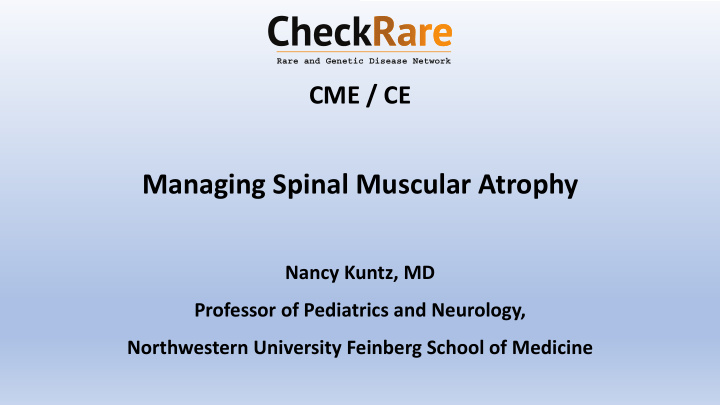



CME / CE Managing Spinal Muscular Atrophy Nancy Kuntz, MD Professor of Pediatrics and Neurology, Northwestern University Feinberg School of Medicine
SMA Spinal Muscular Atrophy • A genetic neurodegenerative disorder • Mutations in SMN1 gene leads to reduced SMN protein • Reduced SMN protein levels results in a plethora of cellular events that can lead to neuronal degeneration • Multiple systems are affected, requiring a multidisciplinary approach • Treatments are available that target the pathophysiology Shorrock HK et al. Drugs. 2018; 78: 293-305. Bharucha-Goebel D, Kaufmann P. Curr Neurol Neurosci Rep. 29017;17:91
Multiple Specialties Mercuri E et al. Neuromusc Disord. 2018; 28: 103-115. Licensed under: https://creativecommons.org/licenses/by-nc-nd/4.0/.
Survival in Type 1 SMA: Effect of Standard of Care Death Death or Ventilation > 16 hr/day 1995-2006 1980-1994 Oskoui M, et al. Neurol . 2007;69:1931-36. Images provided by Dr. Kuntz.
Multiple Disciplines • Coordinator • Usually a neurologist or pediatric neurologist • Neuromuscular care • Metabolic bone health • Orthopedic care • Pulmonology • Nutrition/Gastrointestinal care • Other (Physiotherapy, Pediatrics, General Practice) • Nurses, Nurse Practitioners Mercuri E et al. Neuromusc Disord. 2018; 28: 103-115.
SMA Consensus Care Guidelines • Stated goals – Improve quality of life – Reduce disease burden • Updated classification system - Non-sitters - Sitters - Walkers
Neuromuscular • Assessment should be performed every 6 months • Therapy program will vary depending on person being a non-sitter, sitter, or walker • Stretching • Positioning • Mobility and exercise • Chest physiotherapy Mercuri E et al. Neuromusc Disord. 2018; 28: 103-115. Images courtesy Dr. Kuntz and CureSMA.
Orthopedic Management • Scoliosis is highly prevalent in SMA type I and II • Hypotonic spinal curves and thoracic kyphosis are also common • Chest deformity, hip instability, contractures, fragility fractures are also common Mercuri E et al. Neuromusc Disord. 2018; 28: 103-115. Licensed under: https://creativecommons.org/licenses/by-nc-nd/4.0/.
• Issues dependent on severity of SMA • Non-sitters • Swallow test will determine intervention/care • Dietician should assess every 3-6 months • Sitters • Swallow test will determine intervention/care • Dietician should assess every 3-6 months • Chewing difficulties and fatigue from eating are common in sitters • Ambulatory • Educate about diet recommended for healthy sedentary person • Calcium and Vitamin D Adapted from Talbot et al. Gene Ther. 2017; 24: 529-533. Licensed under: https://creativecommons.org/licenses/by-nc-nd/4.0/.
Multidisciplinary Approach Clinicians, Nurses, and Other Health Professionals Neurology/Pediatric Neurology Clinic Coordinator Rehabilitation Medicine Pulmonology & Anesthesiology Respiratory Therapy Patients with SMA are optimally treated by a multidisciplinary team Nutrition at a specialty Gastroenterology care center Physical Therapy Orthopedics Genetics/Genetic Counseling Social Work
Image courtesy CureSMA
Pathophysiology and Treatment Parente et al. Ther Adv Neurol Disord. 2018; 11: 1-13. Licensed under: https://creativecommons.org/licenses/by-nc-nd/4.0/.
Nusinersen • FDA approved • Antisense oligonucleotide drug that modifies pre-mRNA splicing of SMN2 to promote increased production of full-length SMN protein • Intrathecal injections • Loading Dose: First three injections, once every two weeks. Fourth injection 30 days after third injection. • Maintenance dose: Once every four months • Phase 3 studies with type 1 and type 2 complete showing the drug to be safe and effective Image courtesy Dr. Kuntz
Onasemnogene Abeparvovec scAAV ITR Continuous Promoter Human SMN Transgene scAAV ITR • Crosses the blood-brain barrier; targets neurons • Non-integrating, nonpathogenic • Rapid onset of effect • Remains stable within the nucleus • Rapid, sustained SMN expression Image courtesy Dr. Kuntz
Risdiplam • Under Priority Review by the FDA (announced November 2019. PDUFA date May 24, 2020) • SMN2 splicing modifier • Numerous clinical trials underway. Preliminary phase 3 data appears promising but results have yet to be published in a peer-reviewed publication. Two pivotal clinical trials (one involving SMA type 1 and one involving SMA type 2/3) Image courtesy Wikimedia Commons
Summary • SMA is a genetic neurodegenerative disorder • Treatment requires a multidisciplinary approach • Treatment dependent on severity • Drugs approved, or in development, are designed to stop progression of the disease. While treatments are effective, these children and young adults will still require extensive care by a number of specialists • Since these medicines can dramatically stop progression which means that early detection (i.e., newborn screening) can have a profound impact on the person’s quality of life (and their families )
Recommend
More recommend